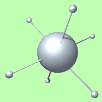|
Introduction:
The Computational Roots of Aesthetic
Interactivity:
"...when human atoms are knit into an organization in which they are used,
not in their full right as responsible beings, but as cogs and levers and rods,
it matters little that their raw material is flesh and blood. What is used as an
element of a machine is in fact an element in a machine." (Wiener, p. 185)
Interactive, telematic art is the
child of developments in cybernetics,
electrical engineering, mathematics,
and computer science;
arguably as much as it is the offspring
of art history. The predictions
and concerns of the pioneering scientists
that developed these fields
facilitated radical new potentials for
interactivity in artistic practice.
A decisive shift in the development
of computational technologies that is
of particular importance to art
occurred with the July 1945 publication
of the essay "As We May
Think" by Vannevar Bush. Bush
was an electrical engineer, Dean of
MIT, and responsible for the development
and administration of
DARPA and the Manhattan Project.
In "As We May Think," he made
many suggestions in an effort to
facilitate the redirection of post-war
agendas in scientific research, but
most notably was his charge that
research in computational systems
shifts from replacing human workers
with computers to building machines
to augment individual human intellect.
The latter involved giving individual users an interface to access
the inner workings of the computer,
allowing for real-time sorting and
contact with data, and forming cross-referenced,
associative paths and
patterns. Bush coined the term
Memex to describe his proposed
associative data handling technique,
the precursor to Hypertext twenty
years later. This concept of a human-centered
agenda in computing was a
radical one in government-sponsored
research, especially after years of
war.
In the 1960s, the visionary scientists
J. P. L. Licklider and Douglas
Engelbart, inspired by Memex, began
to work toward the realization of a
human-centered, intelligence-augmenting
research model for computers.
In 1960, Licklider formulated a
research agenda based on the idea of
a symbiosis between humans and
computers, and later, in 1964, in his
publication "The Computer as a
Communication Device," set an agenda
for interactivity as mutual action
between humans and digital computers,
for the purpose of human communication,
creativity, and transcendence:
|
Vannevar Bush's theoretical
Memex machine,1945
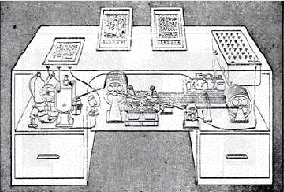 Our emphasis on people is deliberate... We want to emphasize
something beyond one-way transfer: the increasing
significance of the jointly constructive, the mutually reinforcing
aspect of communication
- the part that
transcends... When minds
interact, new ideas
emerge. We want to talk
about the creative aspect
of communication.
Our emphasis on people is deliberate... We want to emphasize
something beyond one-way transfer: the increasing
significance of the jointly constructive, the mutually reinforcing
aspect of communication
- the part that
transcends... When minds
interact, new ideas
emerge. We want to talk
about the creative aspect
of communication.
|
|
As early as 1962, Douglas Engelbart
realized the potentials of the computer
as an intelligence-augmenting
device, and wrote of using the computer
for the development and augmentation
of "mental and cognitive
structuring in the human." (Engelbart,
p. 10)
Diagram of Darker Than Night
Eduardo Kac,1999
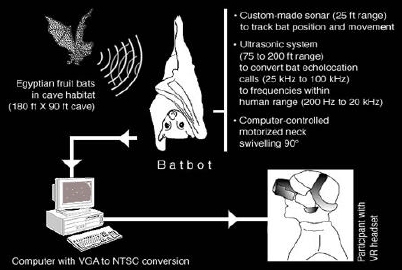 In the late 1960s, Louis Fein, in making
a comprehensive projection of the
growth and dynamic inter-relatedness
of "computer-related sciences,"
includes specific mention of the
enhancement of human intellect by
the cooperative activity of men, mechanisms,
and automata. He profoundly expanded the range of interactivity
when he coined the term "synnoetics"
to describe the cooperative interaction
of people, mechanisms, plant or
animal organisms, and automata into
a system the mental power of which is
greater than that of its components.
Fein described synnoetics as a
"meta-discipline" arising out of the
symbiosis between people, machines,
automata, and other life forms, and
believed that it should be an academic
subject taught in an integrated
fashion. Synnoetics predicts the current development of biological, genetic,
and transgenic art forms currently
under development by artists like
Vibeke Sorensen, Eduardo Kac, and
Tiffany Holmes.
In the late 1960s, Louis Fein, in making
a comprehensive projection of the
growth and dynamic inter-relatedness
of "computer-related sciences,"
includes specific mention of the
enhancement of human intellect by
the cooperative activity of men, mechanisms,
and automata. He profoundly expanded the range of interactivity
when he coined the term "synnoetics"
to describe the cooperative interaction
of people, mechanisms, plant or
animal organisms, and automata into
a system the mental power of which is
greater than that of its components.
Fein described synnoetics as a
"meta-discipline" arising out of the
symbiosis between people, machines,
automata, and other life forms, and
believed that it should be an academic
subject taught in an integrated
fashion. Synnoetics predicts the current development of biological, genetic,
and transgenic art forms currently
under development by artists like
Vibeke Sorensen, Eduardo Kac, and
Tiffany Holmes.
The post-war agendas set out by
Bush, Licklider, Engelbart, and Fein
emphasize the evolution of the human
as the central force in cybernetics,
engineering, and computer science.
Their research forms a clear set of
criteria for the creation of aesthetic,
interactive context creation that is
human-centered. The issues vital to
an aesthetics of interactivity emerging
from their work are the following:
The research and development of
human/machine symbiotic models for
interactivity focus on the augmentation
of the human subject.
The synnoesis between
human/machine/environment emphasizes
a model of mutual exchange
between interacting minds, for the
purpose of emergence and transcendence.
Mutually interactive systems can facilitate
the development of new patterns
of cognition in people, thus confirming
a dynamic of mutual (ex)change. In
the process, the computer is construct -
ed as a dynamically integrated partner
in an associative synnoetic exchange;
an interaction that augments human
communication, creativity, transcendence,
and intelligence.
These scientists mapped a path for
the development of human/computational
interactivity that solidly places at
the center the creation of a symbiotic
or synnoetic, distributed "mind" whose
powers of human realization and transcendence
are greater than the sum of
its parts. After nearly 40 years of
speculation and development in interactive
art, a critical look at the genre
through this synnoetic lens could help
define future paths in the genre.
"How was it for you?"
Interactive Art in
Practice - 1965-Present:
The traditional static, contemplative
art object has now, in the human-centered
synnoetic-interactive paradigm,
become a dynamic, responsive
engine able to instantaneously tailor
its processes and outcome to a
unique dataset of choices and actions
signified by each individual entering
the input field of the aesthetic experience.
In the words of visionary 'interactive
artist,' theorist, and teacher Roy
Ascott:
The emerging new order of art is
that of interactivity, or "dispersed
authorship." The canon is one of
contingency and uncertainty… The
culturally dominate "objet d'art" as
the sole focus... is replaced by the
interface... The focus of the aesthetic
shifts from the observed object
to the participating
subject… (Ascott, p. 243)
Ascott brought to bear on art the theories
and concerns of Licklider and
Engelbart, especially with regard to
"the creative aspect of communication,"
as early as 1966 when he developed
his model for a "cybernetic art
matrix" that functions as a
tool for the mind,
an instrument for
the magnification
of thought, potentially
an intelligence
amplifier...
[T]he interaction of
artefact and computer
in the context
of the behavioural
structure, is equally
foreseeable...
The computer may
be linked to an artwork
and the artwork
may in some sense be a computer.
To understand this "aesthetic shift
from the observed object to the
participating subject," it is necessary
to examine the observed object
(static works of art) through the lens
of the aesthetics of synnoeisis, as
defined above. According to
Webster's Second International
Dictionary, there are two basic conditions
definitive of interactivity:
(1) that interaction implies mutual
acts, and (2), that action does not
necessarily imply a physical act but
can be an effect, suggestion, or representation.
(Webster's) Relative to
the second definition, implied or suggested
action is frequently a property
of traditional physically static forms
like painting and sculpture. Action
can simply be suggested and/or represented
and still reciprocate within
an active dialogue with a viewer
through the suggestion/representation
of action, or through the stimulation of
a reaction in the internal psychic life
or physiological behavior of the participant.
Media theorist Lev Manovich,
in his essay "On Totalitarian
Interactivity (notes from the enemy of
the people)," maintains that classical
and modern art were already
interactive in that they prompted a
viewer to
fill in missing information (for
instance, ellipses in literary narration;
"missing" parts of objects in
modernist painting) as well as to
move his / her eyes (composition in
painting and cinema) or the whole
body (in experiencing sculpture
and architecture). (Manovich,
1996)
Manovich further contends that, compared
to earlier genres, electronic
media often takes an entirely literal
attitude toward interactivity:
equating it (interactivity) with
strictly physical interaction
between a user and an artwork
(pressing a button), at the sake of
psychological interaction. The psychological
processes of filling-in,
hypothesis forming, recall and
identification -- which are required
for us to comprehend any text or
image at all -- are mistakenly identified
strictly with an objectively
existing structure of interactive
links. (Manovich, 1996 )
Manovich and others clearly argue
that all works of art can be described
as interactive, because there always
has been a "reciprocal action," or
feedback condition between the art
object and the viewer. The static
work depicts action, the viewer
responds.
However, the first definition cited
above that interaction implies mutual
acts, is a definitive criterion for interactivity
that eludes the traditional relationship
between static works and
their viewers. This aspect of mutual
action was central to the research
models proposed by Bush, Licklider,
Engelbart and Fein and undermines
Manovich's contention that all works
of art can be described as interactive.
Although one can obviously argue
that the static work of art does act
upon the viewer in a number of very
profound ways, one would be hard
pressed to say that the action is mutual
or reciprocal. The range of physiological,
emotional, spiritual, political,
humanist, psychological, and moral
ideologies impressed upon the viewer
by artists through their work is at the
core of the power of static art; however,
the viewer's actions and will in the
presence of a static work do not
change anything about the physical
structure or corporeal nature of the
object itself. According to this definition,
the aesthetic experience with a
static work of art can be called active,
but not interactive.
Roy Ascott, 1983, working at the TI-745
terminal/printer (Photo: Electra catalogue)
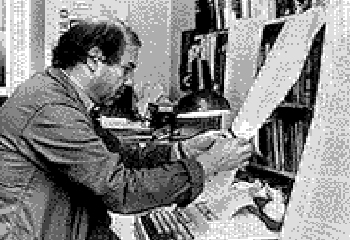 In practice much of the digital work
called interactive offers a very limited
degree of participation as the interactor is confined to basic levels of button-pushing, call and response structures, and prescribed alternatives
within a fixed whole. Ascott's canon
of "contingency and uncertainty" is
often an illusion created by the interface,
masking a logic requiring hardcoded
certainty and order. These
works unintentionally reveal that traditional
print media can offer the same
possibilities of non-linear, random-access
reading as do many CD-ROMs
and websites, albeit with
greater accessibility, stability and
compatibility. In addition, the "interactor's" physical action of pushing a button
or triggering a sensor frequently
seems only related to the consequence
or signification of her action in
a purely literal way, that is, push button,
something occurs. Many interactive
artworks are machine-centered,
both in terms of the interface and the
nature of interaction, while simultaneously
surrounded by a body of discourse
and expectation denying that
this is so. The initial prototype of
"First Order Cybernetics," the feedback
loop, is the model for such interactive,
electronic artworks. The feedback loop is a process frequently
found in machines intended to maintain
a particular state or pattern, like a
governor or thermostat. A simple
feedback loop is analogous to a
closed system of interaction in
Manovich's definition. In closed systems,
we can attribute no intelligence
to the interface, it does not learn from
the action of the environment, simply
leads the participant down an
unchanging branching structure or
pattern of motion, offering pre-rendered
elements or pre-programmed
responses. The individual interactor
is not permitted to follow, in Bush's
terms, an "associative trail." The path
is a pattern, repeatable, and the result
predictable, the internal purpose is the
maintenance of a homeostatic condition
for the machine. In the case of
many interactive pieces, the initial pattern
of machine logic conditions the
interactor's behavior to keep the piece
up and running.
In practice much of the digital work
called interactive offers a very limited
degree of participation as the interactor is confined to basic levels of button-pushing, call and response structures, and prescribed alternatives
within a fixed whole. Ascott's canon
of "contingency and uncertainty" is
often an illusion created by the interface,
masking a logic requiring hardcoded
certainty and order. These
works unintentionally reveal that traditional
print media can offer the same
possibilities of non-linear, random-access
reading as do many CD-ROMs
and websites, albeit with
greater accessibility, stability and
compatibility. In addition, the "interactor's" physical action of pushing a button
or triggering a sensor frequently
seems only related to the consequence
or signification of her action in
a purely literal way, that is, push button,
something occurs. Many interactive
artworks are machine-centered,
both in terms of the interface and the
nature of interaction, while simultaneously
surrounded by a body of discourse
and expectation denying that
this is so. The initial prototype of
"First Order Cybernetics," the feedback
loop, is the model for such interactive,
electronic artworks. The feedback loop is a process frequently
found in machines intended to maintain
a particular state or pattern, like a
governor or thermostat. A simple
feedback loop is analogous to a
closed system of interaction in
Manovich's definition. In closed systems,
we can attribute no intelligence
to the interface, it does not learn from
the action of the environment, simply
leads the participant down an
unchanging branching structure or
pattern of motion, offering pre-rendered
elements or pre-programmed
responses. The individual interactor
is not permitted to follow, in Bush's
terms, an "associative trail." The path
is a pattern, repeatable, and the result
predictable, the internal purpose is the
maintenance of a homeostatic condition
for the machine. In the case of
many interactive pieces, the initial pattern
of machine logic conditions the
interactor's behavior to keep the piece
up and running.
The greatest failure of
such works is that too
often the interactor is
manipulated by the cybernetic
system into believing
that the thought trajectory
they are developing
is their own. The
inevitable realization that
it is both the artist's
thought trajectory and the
conditions of the computational
system they are
following leaves many
viewers with a feeling of
detachment and deception.
Manovich describes this experience:
Now, with interactive media, instead
of looking at a painting and mentally
following our own private associations
to other images, memories,
ideas, we are asked to click on the
image on the screen in order to go
to another image on the screen,
and so on. Thus we are asked to
follow pre-programmed, objectively
existing associations. In short, in
what can be read as a new updated
version of Althusser's "interpolation,"
we are asked to mistake the
structure of somebody else's mind
for our own. (Manovich, p. 61)
Such efforts in interactive art can be
said to actually curtail the participant's
range of free association while simultaneously
espousing assumptions
based in democratic and utopian
ideals of open process and distributed
authorship. Human aesthetic, emotional
and sentient experience is constructed
in terms of the logic of the
machine, rather than, as the developers
of interactivity called for, the other
way around. The goals of interactivity
as previously outlined above by Bush
et al. - human centeredness, associative
paths, mutual action, cognitive
mapping, and by Ascott - undecidability,
potentiality, immateriality, transformation,
mutability - are frequently at
odds with the goals of machine maintenance
and homeostasis.
This is certainly not to say that the
enterprise of interactive art has been
a failed project. Indeed, there have
been works by a number of artists,
Roy Ascott probably being the first,
that exploit the defining agendas of
human-centered, symbiotic interactive
systems to create powerful new
aesthetic contexts. It would seem
that, as digital systems become more
powerful and ubiquitous, the number
of effective works would increase
incrementally, but in my judgment this
is not the case.
If an interactive artwork stops running
before it should, as they frequently
do, then all is lost; but if the cybernetic
system is conceived of as a work
of art, then the facilitation and augmentation
of the aesthetic experience
in the human subject should prevail.
There are a number of issues that
make the maintenance of a human-centered,
cybernetic paradigm a very
difficult task. Whether considering
the aesthetic experience with regard
to the "objet d'art" or the interface, it
is not difficult to analyze and construct
numerous theorems concerning
the composition, structure, and
technology of what Engelbart called
"the explicit-artifact," that is, the work
of computational work of art. What
remains illusive is the nature of the
internal experience of the human
subject when in dialogue with these
artifacts. How is the human affected,
how do we know if the "explicit
human" has changed? As, according to Licklider, mutual exchange is
an optimum condition of symbiotic
interaction, an understanding of the
dynamic, qualitative experience of the
person is necessary in order to contribute
to the production of optimal
aesthetic experiences within interactive
interfaces.
Distributed Minds,
Biometrics, Cognitive
Remapping, and Psi Phenomena:
In 1954, Norbert Wiener wrote, in
"The Human Use of Human Beings,
Cybernetics and Society":
|
But while the universe as a whole, if indeed there is a whole universe,
tends to run down, there are local enclaves whose direction seems
opposed to that of the universe at large and in which there is a limited and
temporary tendency for organization to increase. Life finds its home in
some of these enclaves.
(Wiener, p. 12) |
|
There are enclaves of cybernetic
activities, some within the conventional
canons, and some at the
fringes or entirely outside the realms
of acceptable art or science that shed
light into the mysteries of dynamic
human subjectivity.
Distributed Mind:
Roy Ascott began exploring concepts
of "distributed mind" and creative
communication networks in his cybernetic
experiments in education and
art in the early 1960s. He created
many interactive works in the 1960s
and 70s where "participators" were
able to shape the current state of a
given work. His model for the "cybernetic
art matrix" finally came to fruitition
in 1983 with the exhibition of his
"La Plissure du Texte" at the Musée
de l'Art Moderne de la Ville de Paris.
Edward Shanken, In "Telematic
Embrace: A Love Story? Roy
Ascott's Theories of Telematic Art,"
offers the following description of this
seminal work:
Roy Ascott's La Plissure du Texte, 1983
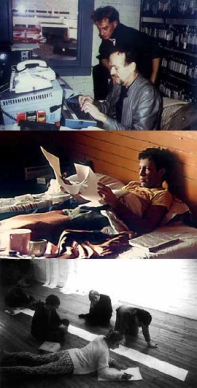
Roy Ascott's La Plissure du Texte
(The Pleating of the Text), 1983, was
identified by Leonardo editor Roger
Malina as an unsurpassed landmark
in the history of Telematic Art. This
work explored the potential of computer
networking for interactive creative
exchange between remote participators,
first theorized by Ascott
in 1966. The project was produced
as part of the Electra exhibition organized
in 1983 by art historian
Frank Popper at the Musée de l'Art
Moderne de la Ville de Paris. La
Plissure du Texte allowed Ascott and
his collaborators at eleven locations
in the US, Canada, Europe, and Australia
to experiment with what the artist
has termed "distributed authorship."
Each remote location represented
a character in the "planetary
fairytale," and participated in collectively
creating and contributing texts
and ASCII-based images to the interactive
unfolding, or distributed
authorship, of the emerging story.
Artist Hank Bull, who participated
in the event from the Vancouver
node described "the result of this intense
exchange" as a "fat tome of
Joycean pretensions that delved
deep into the poetics of disembodied
collaboration and weightless
network rambling." (Shanken, 2001)
Ascott's work clearly pre-dates the
internet, net art, MUDs and MOOs
and is a profound realization of a distributed
realization of Vannevar
Bush's Memex. Anecdotal accounts
from the artists that participated in
"La Plissure du Texte" indicate qualitatively
that their interaction was a
profound experience, free associative,
surreal, and full of unforeseen
narrative twists. It must be pointed
out however, that - unlike many
of Ascott's analogue works of the
60s and 70s - visitors to the exhibition
in Paris were involved primarily
as spectators immersed in a textual
space, unable to affect the direction
of the work.
Biometrics and
Cognitive Mapping:
Doug Engelbart's belief that interactive
systems could change cognitive
structures in human participants finds
its fruition in the growing number of
interactive artworks involving real-time
biometric data flows. The use of biometrics,
especially biofeedback, as a
method of interacting with aesthetic
interfaces, dates back to Jean Millay's
Stereo Brainwave Biofeedback Light
Sculpture of 1971. The interface was
based in R. Timothy Scully's portable
Aquarius Electronics Alphaphone™, a
brainwave analyzer that sorted brainwave
frequencies into sound signals.
John Millay's Brainwave Light Sculpture, 1971

The Stereo Brainwave
Biofeedback Light Sculpture
changes its colors and patterns
with changes in thoughts…
Mandela patterns are used so the
visual focus is not distracted when
the lights change… the feedback
tones accompanied feelings of
deep meditation… I wondered if it
would be possible for two people
to learn to synchronize their brainwaves
to improve telepathic communication.
(Millay, p. 9)
Millay has continued to pursue the
question of the use of biofeedback to
improve telepathic communications in
her subsequent experiments in
remote viewing, forging agendas set
forth by Licklider (creative communication,
interaction of minds),
Engelbart (cognitive structuring), and
Bush (intercepting brain transmissions).
An on-going project, "The Meditation
Chamber," being developed by Chris
Shaw, Larry Hodges and Diane
Gromala at the Georgia Institute of
Technology, is a virtual reality-based
program that uses biofeedback to
facilitate meditative states through
video and audio guidance:
Users wear a head-mounted display
with audio and video that
guides them through a series of
sunset and moonrise scenes and
muscle relaxation exercises. The
system also monitors the users'
respiration, pulse rate and sweat
gland activity (a measure of calmness)
to provide real-time biofeedback
regarding the effectiveness of
the virtual experience. (Gromala,
Hodges, and Shaw)
"The Meditation Chamber" augments
individual users abilities
for visualization, a necessary
component to success in the
use of meditation as a healing
therapy.
In Darij Kreuh and Davide
Grassi's "Brainscore:
Incorporeal Communication,"
biofeedback devices and eyetrackers
are used in a virtual
reality performance environment.
The biometric devices
allow two performers to control virtual
avatars projected for an audience in
stereo on a large screen. The stated
aim of "Brainscore" is
to create a controlled flow of information
in terms of audio-visual
messages in order to establish
communication with the audience.
(Grassi and Kreuh)
Darij Kreuh and Davide
Grassi's Brainscore, 2000
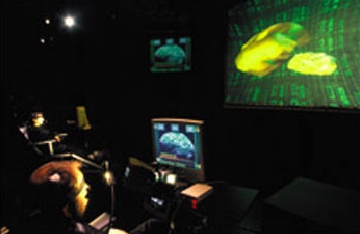 "Brainscore" was first
performed in the Cultural
and Congress Centre in
Ljubljana, Slovenia, in
September of 2000 and
continues to tour. Kreuh
and Grassi contend that
"Brainscore" offers their
audience a completely new
point of view, "leading the
audience to perceive a concrete
co-existence (as a
kind of promiscuous copenetration)
of two Realities at the
same time." (Grassi and Kreuh)
"Brainscore" was first
performed in the Cultural
and Congress Centre in
Ljubljana, Slovenia, in
September of 2000 and
continues to tour. Kreuh
and Grassi contend that
"Brainscore" offers their
audience a completely new
point of view, "leading the
audience to perceive a concrete
co-existence (as a
kind of promiscuous copenetration)
of two Realities at the
same time." (Grassi and Kreuh)
In each of these pieces, the biometric
interface sets up a reflexive cybernetic
loop where the human's output, in the
form of electronic impulses, alters the
machine's output of images, motion,
and sound. In turn, the output of the
machine, as sensory stimulas,
becomes the new condition of input
for the human subjects. "Brainscore"
creates a larger, telematic loop in that
it brings an audience into the reflexive
process. The response the human
subject receives in biofeedback is an
indication of internal dynamics related
to emotional or involuntary systems of
the human's body. Biofeedback
encounters, like the use of virtual
environments in phobia treatment
(Hodges), have proven effective in
creating new relationships to physiological
and psychological conditions in
human subjects through the process
of cognitive remapping in the mind
and body of the interactor. Clearly, in
these interactive artworks Engelbart's
goals related to the augmentation of
mental and cognitive structuring in the
human brain are occuring. It is clear
that technologically mediated works of
art that employ biofeedback interfaces
can facilitate mutually interactive,
quantifiable states in which all the elements
of the cybernetic system - the
human, the machine, and the information
- are in a contingent state of
dynamic, reciprocal change.
Art/Psi Phenomena:
Must we always transform to
mechanical movements in order to
proceed from one electrical phenomenon
to another? Might not
these currents be intercepted,
either in the original form in
which information is conveyed to
the brain, or in the marvelously
metamorphosed form in which
they then proceed to the hand?"
(Bush, p. 107)
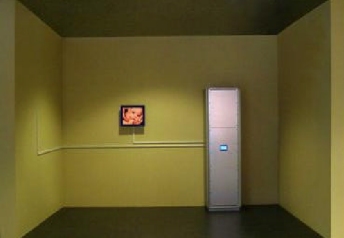 Danish artists Christian Skeel and
Morten Skriver, in partnership with
PEAR (The Princeton Engineering
Anomalies Research Laboratory)
have built and installed "The Trapholt
Experiment" at the Trapholt Museum
for Moderne Kunst in Denmark in
March 3, 2001. The one-year-long
installation is designed to determine
whether human consciousness is
capable of interacting with and affecting a microprocessor. The installation
consists of a custom computer that
generates a random sequence of
numbers, and of a computer monitor.
The monitor hangs on a wall in a small
room; the computer is entirely hidden
from view. The monitor displays an
image that constantly changes from a
depiction of a newborn child to white
noise. The random number generator determines second by second
whether a given pixel is part of the
image of the child or part of the white
noise. The system documents its
decisions in real time and is
extremely accurate. The laws of
probability state that in this random
system, the image of the child will be
visible 50% of the time. The monitor
is the only interface, there are no
additional sensors or input devices.
Danish artists Christian Skeel and
Morten Skriver, in partnership with
PEAR (The Princeton Engineering
Anomalies Research Laboratory)
have built and installed "The Trapholt
Experiment" at the Trapholt Museum
for Moderne Kunst in Denmark in
March 3, 2001. The one-year-long
installation is designed to determine
whether human consciousness is
capable of interacting with and affecting a microprocessor. The installation
consists of a custom computer that
generates a random sequence of
numbers, and of a computer monitor.
The monitor hangs on a wall in a small
room; the computer is entirely hidden
from view. The monitor displays an
image that constantly changes from a
depiction of a newborn child to white
noise. The random number generator determines second by second
whether a given pixel is part of the
image of the child or part of the white
noise. The system documents its
decisions in real time and is
extremely accurate. The laws of
probability state that in this random
system, the image of the child will be
visible 50% of the time. The monitor
is the only interface, there are no
additional sensors or input devices.
|
If the results of the Trapholt Experiment correspond
to those arrived at by the PEAR
Laboratory during the previous twenty years of
research, they will be yet further indication that
consciousness is not a phenomenon limited to
the human brain but one that can transcend
physical limits, with the potential to interact with
anything in the world. (Skeel and Skriver)
|
This experiment is the first work of
art that attempts to document and
measure psi phenomena. Psi
research began in earnest in the
1880s through a series of experiments
started by the British physicist
Sir William Barrett. Psi phenomena
are defined as interactions between
organisms and their environment, or
the environment and organisms, in
which it appears that information has
been passed, or that an influence
has occurred that cannot be understood
by conventional scientific
explanations of communications and
sensorial channels. (Radin, 1997)
The research has shown that man is
capable of using his consciousness
to affect these systems to a slight
but nevertheless decisive degree.
The research also seems to indicate
that the effect works differently with
groups than individuals, backwards
and forward in time, and over great
geographical distances. "The
Trapholt Experiment" cleverly
exploits a basic human desire to see
life and order rather than death and
chaos, and sets out to measure
whether our innate will for survival
can influence our environment.
 Although this work does not seem to
participate in a system of mutual
interaction, as outlined by Licklider, it
is of great importance. This
research may represent a fourth
stage in the development of cybernetics,
as it introduces an entirely
new channel for information
exchange and communication
between humans and machines.
The "Trapholt Experiment" uses
technology in a profound and innovative
way, not to augment or
extend human consciousness, but
to measure the extent to which the
boundaries of human consciousness
are not known. In Psi phenomena,
consciousness only needs amplification
to be measured, thus consciousness
augments technology,
not the other way round. Psi phenomena as a form of wireless communication
may be of profound
importance to the future development
of interactive, synnoetic interfaces,
augmented, distributed minds,
as well as to a new, undefined context
for aesthetic experience.
What is important to an understanding
of how interactivity in art can
meet its full potential is the shift from
what N. Katherine Hayles describes
as a focus on the silicon/information
transfer side of the interactive equation
to a focus on the poetic evolution
of the human subject. One
could argue that this factor, poetic
evolution, is the most important criterion
for success in a work of art.
The need for human focus comes
into high relief in technologically
mediated artworks, as the technological
demands to maintain
machine homeostatis are so great,
and because information appears to
have "lost its body." In the case of
distributed, biometric and anomalous
interactivities, information spirals
through the cybernetic exchange,
from organic to the inorganic and
back, while remaining grounded in
human intentionality and perception.
The grounding of information in the
human will-to-consciousness gives
information back its body, and re-orients
the focus of cybernetic discourse.
The question becomes how
can the human will-to-consciousness
extend our technological systems,
not how can technology be a vehicle
for consciousness. Experiments cojoining
late stage cybernetics,
human biometrics, psi phenomena,
and aesthetic interactivity represent
a new vehicle for the evolution of
human sentience that conditions a
new outcome, or object of inquiry.
This new condition is neither art nor
science, but a cumulative transformation
of the discourses of both; a
transformation that celebrates
human connectivity and the will to
survive.
Although this work does not seem to
participate in a system of mutual
interaction, as outlined by Licklider, it
is of great importance. This
research may represent a fourth
stage in the development of cybernetics,
as it introduces an entirely
new channel for information
exchange and communication
between humans and machines.
The "Trapholt Experiment" uses
technology in a profound and innovative
way, not to augment or
extend human consciousness, but
to measure the extent to which the
boundaries of human consciousness
are not known. In Psi phenomena,
consciousness only needs amplification
to be measured, thus consciousness
augments technology,
not the other way round. Psi phenomena as a form of wireless communication
may be of profound
importance to the future development
of interactive, synnoetic interfaces,
augmented, distributed minds,
as well as to a new, undefined context
for aesthetic experience.
What is important to an understanding
of how interactivity in art can
meet its full potential is the shift from
what N. Katherine Hayles describes
as a focus on the silicon/information
transfer side of the interactive equation
to a focus on the poetic evolution
of the human subject. One
could argue that this factor, poetic
evolution, is the most important criterion
for success in a work of art.
The need for human focus comes
into high relief in technologically
mediated artworks, as the technological
demands to maintain
machine homeostatis are so great,
and because information appears to
have "lost its body." In the case of
distributed, biometric and anomalous
interactivities, information spirals
through the cybernetic exchange,
from organic to the inorganic and
back, while remaining grounded in
human intentionality and perception.
The grounding of information in the
human will-to-consciousness gives
information back its body, and re-orients
the focus of cybernetic discourse.
The question becomes how
can the human will-to-consciousness
extend our technological systems,
not how can technology be a vehicle
for consciousness. Experiments cojoining
late stage cybernetics,
human biometrics, psi phenomena,
and aesthetic interactivity represent
a new vehicle for the evolution of
human sentience that conditions a
new outcome, or object of inquiry.
This new condition is neither art nor
science, but a cumulative transformation
of the discourses of both; a
transformation that celebrates
human connectivity and the will to
survive.
WORKS CITED:
Ascott, Roy, "Is There Love in the
Telematic Embrace?", Art Journal,
49:3 (Fall 1990)
Bush, Vannevar. "As We May
Think," The Atlantic Monthly,
Volume 176 No. 1 (July 1945),
pp. 101-108.
Engelbart, Douglas C.
"Augmenting Human Intellect: A
Conceptual Framework." Summary
Report AFOSR-3223 under
Contract AF 49(638)-1024, SRI
Project 3578 for Air Force Office of
Scientific Research, Stanford
Research Institute, Menlo Park,
Ca., October 1962.
Grassi, Davide and Darij Kreuh,
"Brainscore--incorporeal communication,"
http://www.brainscore.org/
Gromala, Diane, Hodges, Larry
and Shaw, Christopher, "The
Meditation Chamber," GVU Center,
Georgia Institute of Technology, http://www.gvu.gatech.edu/gvu/meditation/proj_frameset.htm
Hayles, N. Katherine, How we
Became Posthuman (The
University of Chicago Press:
Chicago / London, 1999)
Licklider, J. C. R, "The Computer
as a Communication Device,"
reprinted from Science and
Technology (April 1968)
Manovich, Lev, The Language of
New Media (MIT Press, Leonardo
Books: Cambridge, MA, 2001)
Manovich, Lev "On Totalitarian
Interactivity (notes from the enemy
of the people)"
http://www.manovich.net/text/totalitarian.html (1996)
Millay, Jean, Multidimensional
Mind: Remote Viewing in
Hyperspace, A Universal
Dialogues Book (North Atlantic
Books: Berkeley, CA, 1999)
Shanken, Edward A. "Telematic
Embrace: A Love Story? Roy
Ascott's Theories of Telematic Art,"
Telematic Connections Timeline,
http://telematic.walkerart.org/timeline/timeline_shanken.html#
Radin, Dean, The Conscious Universe: The Scientific Truth of Psychic Phenomena
(HarperEdge: New York, 1997)
Skeel and Skriver, "Trapholt
Eksperimentet," Sensualogic.org,
http://www.sensuallogic.org/Members/skeel/category_1019984899/frameset.html
Wiener, Norbert, The Human Use
of Human Beings: Cybernetics
and Society (Doubleday Anchor
Books: Garden City, NY, 1954)
|
